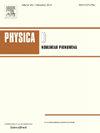保证稳定二次模型及其在SINDy和算子推理中的应用
IF 2.9
3区 数学
Q1 MATHEMATICS, APPLIED
引用次数: 0
摘要
用于推断动力系统的科学机器学习结合了数据驱动建模、基于物理的建模和经验知识。它在工程设计和数字孪生中起着至关重要的作用。在这项工作中,我们主要关注一种算子推理方法,该方法构建动态模型,最好是在低维的情况下,对模型结构有一个先验假设,通常由已知的物理或专家给出。然后,对于推理,我们的目标是通过建立适当的优化问题来学习模型的算子。动力系统的一个重要性质是稳定性。但是,推断模型不能保证此属性。在这项工作中,我们提出了学习二次型模型的推理公式,该模型设计稳定。准确地说,我们讨论了局部稳定和全局稳定的二次系统的参数化问题。此外,对于没有稳定点但有界的二次系统(如混沌Lorenz模型),我们讨论了如何在学习过程中参数化这种有界行为。利用这些参数化,我们建立了推理问题,然后使用基于梯度的优化方法来解决这些问题。此外,为了避免数值导数,并且仍然学习连续系统,我们使用微分方程的积分形式。我们给出了几个数值例子,说明了稳定性的保持,并讨论了它与现有的最先进的推断算子的方法的比较。通过数值算例,我们还演示了如何使用所提出的方法来发现控制方程和能量守恒模型。本文章由计算机程序翻译,如有差异,请以英文原文为准。

Guaranteed stable quadratic models and their applications in SINDy and operator inference
Scientific machine learning for inferring dynamical systems combines data-driven modeling, physics-based modeling, and empirical knowledge. It plays an essential role in engineering design and digital twinning. In this work, we primarily focus on an operator inference methodology that builds dynamical models, preferably in low dimensions, with a prior hypothesis on the model structure, often determined by known physics or given by experts. Then, for inference, we aim to learn the operators of a model by setting up an appropriate optimization problem. One of the critical properties of dynamical systems is stability. However, this property is not guaranteed by the inferred models. In this work, we propose inference formulations to learn quadratic models, which are stable by design. Precisely, we discuss the parameterization of quadratic systems that are locally and globally stable. Moreover, for quadratic systems with no stable point yet bounded (e.g., chaotic Lorenz model), we discuss how to parameterize such bounded behaviors in the learning process. Using those parameterizations, we set up inference problems, which are then solved using a gradient-based optimization method. Furthermore, to avoid numerical derivatives and still learn continuous systems, we make use of an integral form of differential equations. We present several numerical examples, illustrating the preservation of stability and discussing its comparison with the existing state-of-the-art approaches to infer operators. By means of numerical examples, we also demonstrate how the proposed methods are employed to discover governing equations and energy-preserving models.
求助全文
通过发布文献求助,成功后即可免费获取论文全文。
去求助
来源期刊

Physica D: Nonlinear Phenomena
物理-物理:数学物理
CiteScore
7.30
自引率
7.50%
发文量
213
审稿时长
65 days
期刊介绍:
Physica D (Nonlinear Phenomena) publishes research and review articles reporting on experimental and theoretical works, techniques and ideas that advance the understanding of nonlinear phenomena. Topics encompass wave motion in physical, chemical and biological systems; physical or biological phenomena governed by nonlinear field equations, including hydrodynamics and turbulence; pattern formation and cooperative phenomena; instability, bifurcations, chaos, and space-time disorder; integrable/Hamiltonian systems; asymptotic analysis and, more generally, mathematical methods for nonlinear systems.
 求助内容:
求助内容: 应助结果提醒方式:
应助结果提醒方式:


